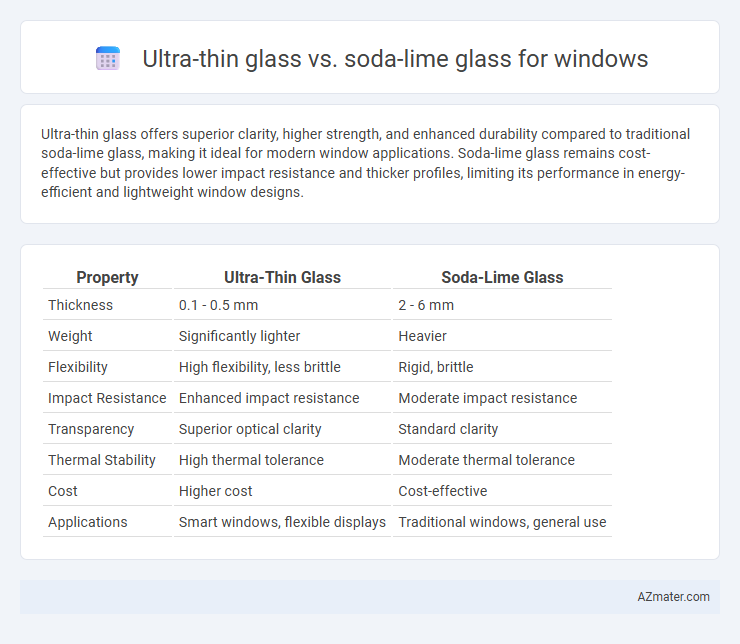Ultra-thin glass offers superior clarity, higher strength, and enhanced durability compared to traditional soda-lime glass, making it ideal for modern window applications. Soda-lime glass remains cost-effective but provides lower impact resistance and thicker profiles, limiting its performance in energy-efficient and lightweight window designs.
Table of Comparison
| Property | Ultra-Thin Glass | Soda-Lime Glass |
|---|---|---|
| Thickness | 0.1 - 0.5 mm | 2 - 6 mm |
| Weight | Significantly lighter | Heavier |
| Flexibility | High flexibility, less brittle | Rigid, brittle |
| Impact Resistance | Enhanced impact resistance | Moderate impact resistance |
| Transparency | Superior optical clarity | Standard clarity |
| Thermal Stability | High thermal tolerance | Moderate thermal tolerance |
| Cost | Higher cost | Cost-effective |
| Applications | Smart windows, flexible displays | Traditional windows, general use |
Introduction to Ultra-Thin Glass and Soda-Lime Glass
Ultra-thin glass, characterized by its thickness below 0.3 mm, offers enhanced flexibility and lightweight advantages compared to traditional soda-lime glass commonly used in windows. Soda-lime glass, composed primarily of silica, sodium oxide, and calcium oxide, is favored for its durability, cost-effectiveness, and ease of manufacturing. The adoption of ultra-thin glass in windows improves energy efficiency and allows for innovative design applications due to its superior thinness and strength.
Composition and Manufacturing Processes
Ultra-thin glass is primarily composed of high-purity silica with minimal additives, allowing for enhanced flexibility and strength, whereas soda-lime glass consists of silica, sodium oxide, and calcium oxide, providing cost-effective durability. Ultra-thin glass is manufactured using fusion or down-draw processes that produce continuous, defect-free sheets with thicknesses below 0.1 mm, while soda-lime glass is typically produced through float glass manufacturing, resulting in thicker, less flexible panels. The precise thermal control and rapid cooling in ultra-thin glass production contribute to its superior mechanical properties compared to the bulkier, more chemically stable soda-lime glass.
Physical Properties Comparison
Ultra-thin glass offers superior flexibility and higher tensile strength compared to conventional soda-lime glass, making it more resistant to cracking and breakage under mechanical stress. Soda-lime glass typically has a higher density and lower elastic modulus, resulting in reduced durability and increased brittleness for window applications. The thermal conductivity of ultra-thin glass is lower, enhancing energy efficiency and providing better insulation than the more conductive soda-lime glass.
Optical Clarity and Transparency
Ultra-thin glass offers superior optical clarity and higher transparency compared to soda-lime glass, making it ideal for applications requiring minimal light distortion. The refined manufacturing process of ultra-thin glass reduces impurities and defects, enhancing light transmission and visual sharpness. In contrast, soda-lime glass typically exhibits lower optical performance due to its composition and thickness, resulting in slightly decreased clarity and transparency.
Strength and Durability
Ultra-thin glass offers superior strength and flexibility compared to traditional soda-lime glass, making it less prone to cracking under stress and impact. Soda-lime glass, while cost-effective and widely used, is more brittle and susceptible to breakage from sudden temperature changes or mechanical force. Advanced ultrathin glass technologies enhance durability by incorporating chemical and thermal treatments, resulting in longer-lasting window solutions ideal for high-performance architectural applications.
Applications in Modern Windows
Ultra-thin glass offers superior flexibility and enhanced durability compared to soda-lime glass, making it ideal for cutting-edge applications such as curved and foldable windows in modern architecture. Its lightweight nature contributes to energy efficiency and ease of installation in high-rise buildings and smart glass technologies. Soda-lime glass remains a cost-effective option for traditional window designs, but ultra-thin glass enables innovative solutions demanding higher performance and design versatility.
Energy Efficiency and Insulation Performance
Ultra-thin glass significantly enhances energy efficiency in windows due to its reduced thickness, allowing for better light transmission and improved thermal insulation compared to standard soda-lime glass. Soda-lime glass, while cost-effective and widely used, has lower insulation properties, leading to higher heat transfer and increased energy consumption for heating and cooling. Ultra-thin glass's advanced manufacturing techniques contribute to superior thermal performance, reducing energy loss and improving overall insulation efficiency in building applications.
Cost and Availability
Ultra-thin glass offers superior transparency and flexibility but typically comes at a higher cost compared to soda-lime glass, which remains the most affordable and widely available option for window applications. Soda-lime glass dominates the market due to its abundant raw materials and efficient manufacturing process, making it the cost-effective choice for large-scale use. The specialized production techniques required for ultra-thin glass limit its availability and increase expenses, restricting its adoption primarily to niche or high-end projects.
Environmental Impact and Sustainability
Ultra-thin glass significantly reduces raw material consumption and energy use during production compared to soda-lime glass, lowering its carbon footprint. Its lightweight properties enable reduced transportation emissions and contribute to improved energy efficiency in buildings through enhanced thermal insulation. Soda-lime glass, while more common and recyclable, generally requires higher energy consumption in manufacturing and results in greater environmental impact over its life cycle.
Future Trends in Glass Technologies
Ultra-thin glass offers superior flexibility and lightweight properties compared to traditional soda-lime glass, driving its adoption in advanced window applications. Innovations in ultra-thin glass manufacturing, such as precision thinning and enhanced durability coatings, are expected to revolutionize smart window technologies by integrating touch sensitivity and energy efficiency. Future trends indicate a shift towards hybrid glass solutions combining ultra-thin glass with electrochromic layers to optimize daylight control and thermal insulation in sustainable building designs.

Infographic: Ultra-thin glass vs Soda-lime glass for Window
 azmater.com
azmater.com